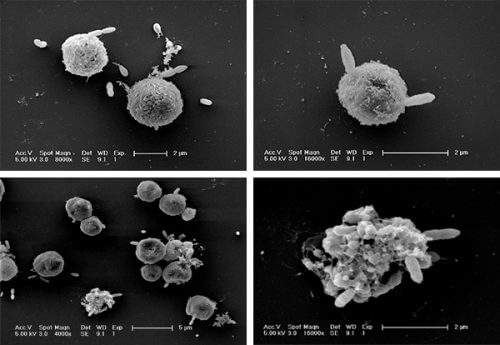Scientists at the Weizmann Institute of Science recently discovered that the rapid disappearance of blooms made up of trillions of single-celled algae known as phytoplankton is made possible thanks to a deadly "cooperation" between a virus and a bacterium

From the marine food chain to the oxygen we breathe - the life and death of the giant blooms in the heart of the ocean greatly affect life on Earth. Scientists at the Weizmann Institute of Science recently discovered that the rapid disappearance of the blooms, which are made up of trillions of single-celled algae called phytoplankton, is made possible thanks to a deadly "cooperation" between a virus and a bacterium. As reported in the scientific journal Science Advances, the study raises the possibility that the algae themselves contribute to their elimination through a sulfuric substance they produce.
Prof. Assaf Vardi from the Department of Plant and Environmental Sciences at the institute and members of his group previously characterized in depth the death of algae following viral infection. However, over time, one would expect the algae to develop resistance to the virus. Since the disappearance of the rash is quick and sharp, the scientists hypothesized that other factors are involved. Prof. Verdi and research student Naa Barak-Gabish decided to look for those factors in the microbiome of the zooplankton, which feed exclusively on the phytoplankton.
Slightly different strains of phytoplankton within the same bloom can respond in opposite ways to the same pathogens. Therefore, a double attack - viral and bacterial - could eliminate the bloom and even prevent the algae strains from developing resistance over time."
Prof. Assaf Verdi and Noa Barak-Gavish. A two-pronged attack
Barak-Gavish and Dr. Miguel Prada, who was at the time a post-doctoral researcher in Prof. Verdi's group, discovered that the microbiome of the zooplankton contained, in addition to the virus, also a certain strain of bacteria. When Barak-Gavish grew the phytoplankton and bacteria together in the laboratory, she saw that the two first grew rapidly side by side, but at some point the bacterial culture took off - while the phytoplankton cells began to die. The researchers also noticed that phytoplankton that was resistant to viral infection more easily succumbed to the bacteria and vice versa. Prof. Vardi explains: "Slightly different strains of phytoplankton within the same bloom can react in opposite ways to those that cause diseases. Therefore, a double attack - viral and bacterial - could eliminate the bloom and even prevent the algae varieties from developing resistance over time."
The bacterium belongs to the Sulfitobacter family, many of whose members specialize in sulfur metabolism. Not coincidentally, the phytoplankton produce the sulfur compound DMSP. Prof. Vardi, together with Prof. Dan Toufik from the Department of Biomolecular Sciences at the Institute and their joint research student, Dr. Uriah Alcolombari, previously isolated and identified the enzyme with which the algae uses DMSP to produce the volatile compound DMS which gives the sea its characteristic smell and even contributes to the formation of clouds in the atmosphere. The two substances, DMSP and DMS, are responsible for many functions in accelerator cells, among other things as a kind of "info-chemicals" - chemical molecules that transmit messages between cells found in the immediate environment.
The various stages of infection in one image (right - close-up): from a healthy algal cell (top left) through a cell to which a bacterium has attached (right) to a damaged and finally dead cell (bottom left)
In the current study it was found that DMSP plays a central role in the relationship between the bacterium and phytoplankton. The algae strains that produced the most DMSP were the ones at the highest risk of being damaged by bacterial infection. The bacteria that feeds on DMSP releases another substance, methanethiol, which has a strong smell of ripe cheese. "Instead of the typical smell of the sea, a pungent aroma appeared that indicates the battle waistline of the algae," says Barak-Gabish. "We hypothesize that these interrelationships have consequences not only for the fate of algae blooms, but also for sulfur and carbon cycles in the oceans, so we are curious to understand the process - from the cellular mechanism to the wide-ranging effects on the marine environment," says Barak-Gabish.
These days the researchers are characterizing the mechanism by which the bacterium kills the algae and how DMSP is involved in it. "Understanding the cellular and molecular mechanism of the interaction will allow us to discover biological markers, which will then be used to shed light on the ecological impact of these interactions on the algal blooms in the natural environment, which interests us the most," says Prof. Verdi. For this purpose, a research expedition went out last summer, which included scientists from Europe and the United States led by Prof. Verdi, to investigate the effect of interactions with bacteria and viruses on the dynamics of algae blooms in the fjords in Norway, the natural habitat of these blooms.
Dr. Chuan Ku, Dr. Sergey Malitsky and Prof. Assaf Aharoni, from the Department of Plant and Environmental Sciences at the Institute, and Dr. Stephen Green from the University of Illinois at Chicago also participated in the study.

One response
The questions that arise: Why is the phytoplankton damaged only now? After all, they constantly produce and secrete DMSP and DMS. What changed that made them now vulnerable to both viruses and bacteria? What about their marine environment made them vulnerable? Is there a factor/factors that produce a favorable environment for the viruses and bacteria to damage the phytoplankton? How is the "cooperation" between viruses and bacteria possible?